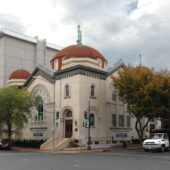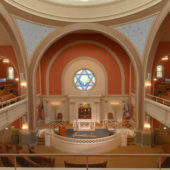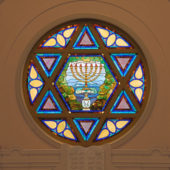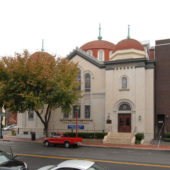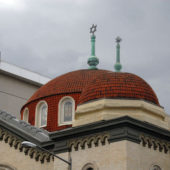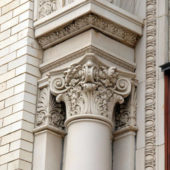Dedicated as a Conservative synagogue in 1908 and then serving as an African Methodist Episcopal Church for the latter part of the 20th century, Sixth & I was saved from being turned into a nightclub and, instead was re-purposed as a non-denominational, non-traditional synagogue.
Sixth and I is not your “standard” Synagogue. For starters, the rabbi is an attractive, 30s-ish woman, Shira Stutman. The Synagogue is considered to be non-denominational, does not have a membership roster and is definitely not traditional. This Washington D.C. Synagogue caters largely to young professionals in their 20s and 30s. They are invited not only to explore their Jewish heritage and what that means in today’s world, but also to enjoy programs at the Synagogue, offering the best of modern music, film, and cultural discussions by experts across a diverse range of fields.
Sixth and I of course, did not start out this way. In 1852, twenty-one German Jews founded the first congregation in Washington D.C. However, this was a Reform congregation, and in 1869, thirty-eight members resigned to form the Adas Israel Hebrew Congregation, with more conservative practices. The congregation dedicated its first sanctuary on the corner of Sixth and G Streets in 1876. By 1899, the congregation had outgrown the sanctuary and required a larger building. In 1905 a buyer had been secured for the premises at Sixth and G Streets and the present lot at the corner of Sixth and I Streets was purchased. In 1906, architect Louis Levi and builder Arthur Coswill had been retained to build the Synagogue at Sixth and I Streets, and construction began. On January 5, 1908 the Synagogue was dedicated.
The Synagogue was built in a Moorish, Romanesque Revival design, with domed rooftops and columns flanking the front entrance. Inside, there is a large sanctuary with terracotta walls, and a multi-arched ceiling tapering into columns with an upper balcony in cream and gilded gold. The bimah, located at the front of the sanctuary, is situated in a recessed arch, with a beautiful round stained class window behind it, featuring the Star of David. Further stained glass windows adorn the sides of the sanctuary, both upstairs and downstairs. Brass menorahs are situated on either side of the bimah. Sixth and I is proud to own four restored Torah scrolls that have survived the holocaust.
By 1945 the congregation had again outgrown it’s building, and acquired a triangular premises, flanked by Connecticut Avenue, Porter, and Quebec Streets. The Sixth and I Streets building was sold to Turner Memorial A.M.E. Church, an African Methodist Episcopal church in 1951. In 1979 they dedicated a four-story multi-purpose building on the lot next door to provide additional room for the growing church.
In 2002 Turner Memorial put the church property up for sale, as it was relocating to Maryland. The Jewish Historical Society, in conjunction with the Jewish community, purchased the property. It was subsequently restored to its original state and on April 22, 2004, Sixth and I rededicated the Synagogue.
In 2005 President George W. Bush visited the Synagogue. In 2007 the Synagogue received the Slingshot Award, acknowledging it as one of the 50 most innovative Jewish organizations in the country, and the only one honored in Washington. In 2008 Nancy Pelosi, the Speaker of the House, visited Sixth and I, giving a speech from her book, Know your Power: A Message to America’s Daughters. In 2008, Newsweek recognized the Synagogue as one of the “25 Most Vibrant Congregations in the Country.” In 2009, the wife of the Vice-President, Dr. Jill Biden, visited the Synagogue with Greg Mortenson, co-founder of the Central Asia Institute, founder of Pennies for Peace, author of ‘Three Cups of Tea’ and ‘Stones into Schools,’ for a lecture.
Aside from regular services, Sixth and I regularly hosts events with authors, filmmakers, actors, entrepreneurs, activists, academics, comedians, politicians and other people of wide cultural appeal. Sixth and I has hosted such names as Adele, Bryan Adams, Salmon Rushdie, and Lewis Black. There is also a very active young mothers group that meets to inspire and encourage young mothers in their important and demanding roles.
This unusual, stimulating synagogue seeks to meet the needs of our capitol’s young professionals and their families. They have taken risks and are using modern and unusual means to reach out to the community and are doing an outstanding job of it.

